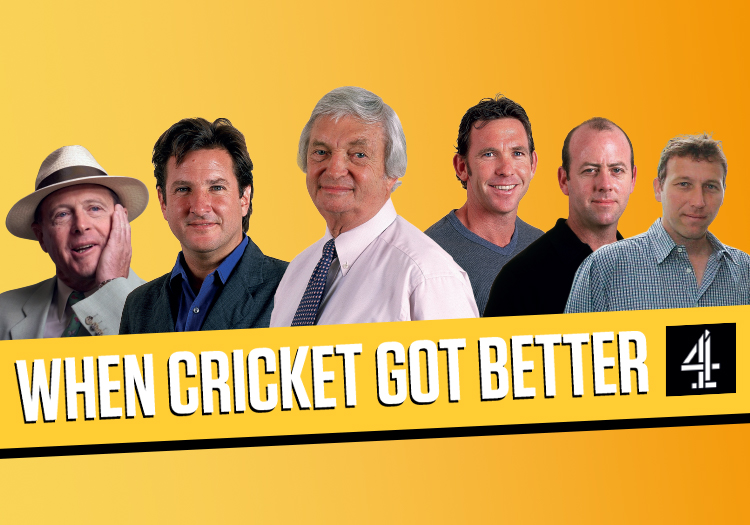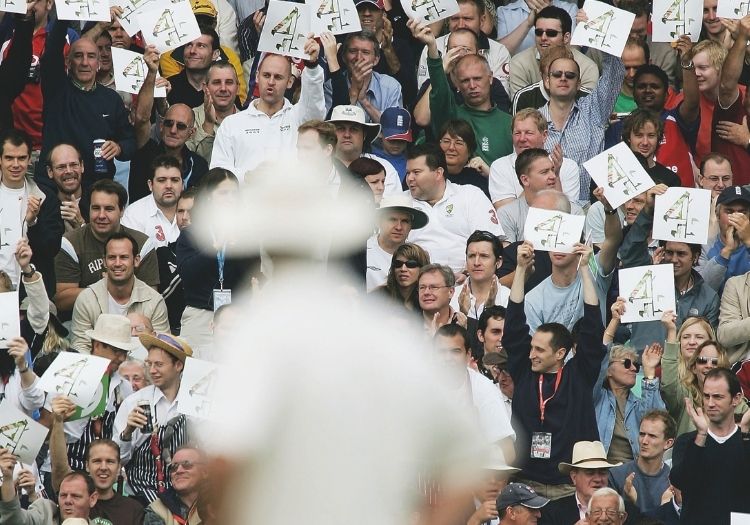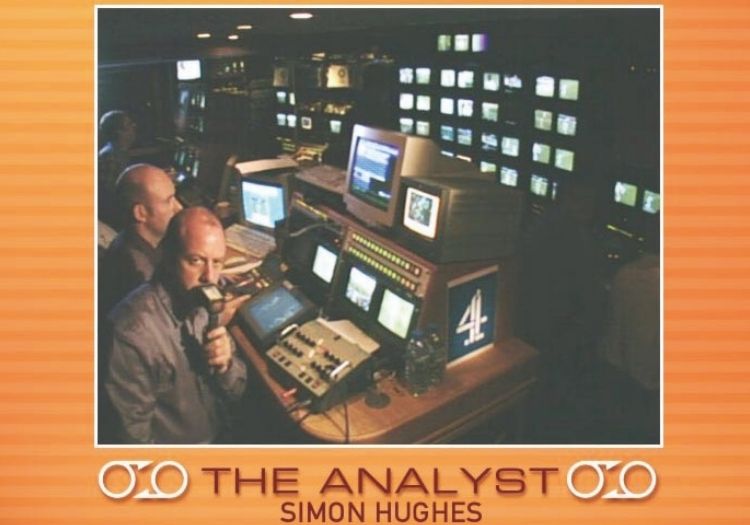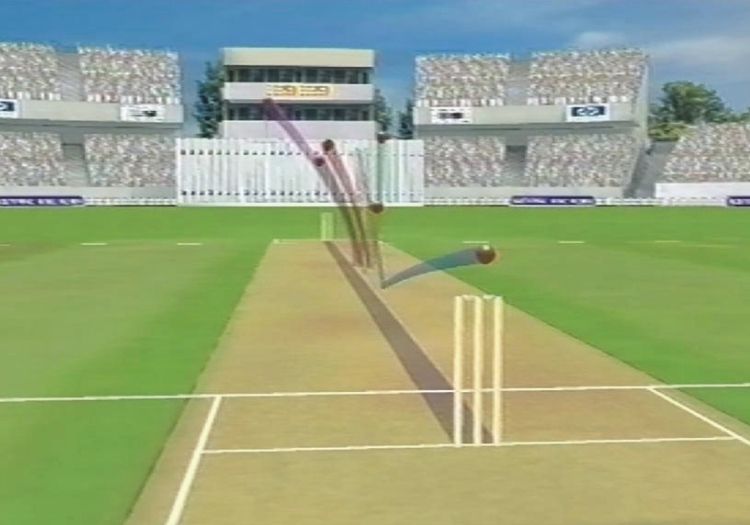Simon Hughes reflects with Mike Atherton, Mark Nicholas and Ian Smith on how Channel 4's stint of live cricket coverage, which began 20 years ago, was both groundbreaking and trend-setting


Channel 4 to show India-England series live in the UK
If you watched a fair bit of the 2019 World Cup you’ll probably have seen many re-runs of that 1999 semi-final when Lance Klusener set off for the winning run, Allan Donald started, stopped, dropped his bat and was run out by the length of the pitch to gift Australia victory.
The really illuminating thing about that incident is not the excruciating indecision on South Africa’s part, initiating a series of notorious choking moments in major tournaments, but the quality of the television coverage. The pictures are grainy, the colour watery and there are only a couple of replay angles as the critical moment unfolds. Even the sound is fuzzy. It is incredible to think that was only 20 years ago. It looks and sounds like the 1960s. It was, of course, the penultimate cricket match covered live by the BBC.
The Beeb has incredible assets, but innovation has never been one of them. I was part of the BBC presentation team working on the cricket then, as a pitchside reporter. I suggested ideas for little features to help viewers better understand the game. But there was a reluctance from the production team to add to the basic ball-by-ball coverage, and in between overs there would be a lingering look at the scorecard or cutaways to the crowd. They weren’t even dressed as nuns or constructing a beer snake then.
The general public were apprehensive when Channel 4 stole the rights off a napping BBC for England home matches from 1999 onwards. They feared that cricket would now be shown from odd, low angles with a house music underlay, there’d be a camera in the showers and transvestite commentators with tattoos and piercings. There was a feeling that cricket would be cheapened and almost ridiculed.
I sensed it was a major opportunity. Fewer and fewer people out there actually understood cricket. My first pitch to Channel 4 head of sport, Michael Jackson, mentioned ‘jargonbusting’ and ‘analysis’ and ‘demystifying’ and contained a rudimentary sketch of a round magnetic board to illustrate field settings. To my initial amazement these proposals were accepted immediately and I was soon added to a team that already included Mark Nicholas and Richie Benaud. And there, essentially, is why Channel 4’s coverage was so acclaimed (it won 30 broadcast awards in seven years).
There was an enthusiastic receptiveness to ideas that were smoothly introduced by Nicholas and keenly endorsed by Benaud. The main priority of the man charged with assembling the production team, seasoned Sunset+Vine producer Gary Franses, who I nicknamed ‘the thin controller’ for his wiry frame, was finding people who shared his innate fascination for the game.
It started with The Cricket Roadshow – an hour’s live broadcast on a Saturday morning from a county or club ground (a whole hour? outside???!!!) with, shock horror, a female co-host (Sybil Ruscoe) and a funky new theme tune (‘Mambo No.5’, reimagined by Lou Bega) and continued with some interesting gizmos such as a device that used the stump microphones to gauge whether the ball had touched the bat (which Benaud loved and christened ‘snicko’) and a virtual red mat superimposed on the pitch which showed whether the ball had pitched in line (the red zone). The graphics were bright and colourful, rather than the staid BBC versions resembling telegrams from the War Office.

Fans wave Channel 4 cards during the last day of the 2005 Ashes – and the last day of free-to-air Test coverage in the UK
Our live match debut was the second England v New Zealand Test, at Lord’s in 1999 (as part of the deal, Sky had exclusivity to one Test in the first series of the summer). In the commentary box were Nicholas, Benaud, Dermot Reeve, Ian Smith, Wasim Akram and James Whitaker. I sat in a darkened truck assembling short features with the help of master-editor Damien Dexter and a phalanx of videotape producers each manning one camera angle with the help of a sophisticated digital tape recorder called an EVS machine which could instantly rewind pictures, create split screens and accommodate drawing on the screen.
It sounds old hat now, but it facilitated an ability to quickly show dismissals or incidents from previous matches. I built up a wobbly stack of archive tapes next to my Analyst position.
Our principle aim was to make cricket coverage more interesting and informative: to tell ‘why’ as well as ‘what’. Part of our motivation came from people who said they often watched cricket on the TV but turned the sound off and listened to the radio commentary. We wanted our content to be so intriguing viewers would turn the sound up. We soon won over doubters and the combination of Benaud’s ageless enthusiasm and authority and Nicholas’ calm and effortless linking was a winning one. “The camera loves him,” wrote Giles Smith in The Daily Telegraph, “and its love does not, shall we say, go unrequited.”
Benaud invariably arrived early in the commentary box to set up his little nest of computer with train screen-saver chugging across the screen, copies of the Racing Post and Tom Smith’s Laws of Cricket and his tupperware of home-made banana sandwiches. His enthusiasm was contagious and he loved the analytical approach, even when it went a bit wrong.
One day the pen I was using to illustrate the direction of a ball malfunctioned and all these coloured lines appeared all over the screen. I handed back to him apologising for the error. “Very interesting piece of analysis, Simon,” Richie said live on air, “and don’t worry about the drawing. Picasso sometimes used to struggle on Sundays.” One viewer wasn’t quite so impressed. “Rubbish, Hughes!” he wrote, “we can do without all your silly cartoon drawings. Someone should lock you up in your caravan and throw away the key.”
The most groundbreaking of our innovations was the ability to make the batsman semi-transparent, an idea created by a former cameraman Simon ‘Stormin’ Normington, also the coverage’s graphics designer, who employed what is called a ‘half-mix’ (a merge of an actual delivery with a screen grab of the stumps from the same fixed camera.) This allowed the viewer to see the stumps behind the batsman’s pad or body. It gave more of a clue to potential lbws.
This prompted an approach from a former minor counties cricketer, Paul Hawkins, whose expertise in missile guidance technology had given him an idea. He invited us to a research centre in Hampshire where a bowling machine was set up to fire balls at a life-size mannequin of a batsman. Three cameras were set up outside to film each ball, and the pictures were relayed to a computer nearby which then plotted the precise path of the ball after it passed (or hit) the ‘batsman’.
We could immediately see this technology’s potential and trialled it at Lord’s. We were amazed at what it revealed in terms of bounce and trajectory of deliveries. Hawk-Eye was born on May 17 2001 during the England v Pakistan Test at Lord’s. It goes without saying that it has revolutionised not only cricket, tennis and football but all sport. It is now used in 113 different sports (and Hawkins is a tax exile!).

Simon Hughes in his role as The Analyst
Channel 4 aided this enlightened approach to sports coverage with a major advertising campaign – remember the billboards stating ‘Cricket Just Got Better’? – documentaries, live music at the venues and fan parks with giant screens. Money seemed to be no object. As the England team emerged out of the darkness of 1999 – when they were officially bottom of the world rankings – and started to play enterprising cricket, the message that this was quite a good product gradually caught on. Other broadcasters even copied Channel 4 cricket’s engaging, analytical style.
Not everything worked. There was irritation when the coverage shifted to FilmFour to accommodate Saturday horse-racing, or ended at 6pm for The Simpsons. (Test start times were brought forward to 10.30am.) Highlights were on so late that the programme should have been called Yesterday at the Test. Some of the early commentators added little and it was pointed out during a series against Zimbabwe that our visiting ‘expert’ Andy Whittall had a Test batting average of 7.59 and seven wickets at 105.14 apiece. When we covered ODIs for highlights (without Benaud) we reckoned Sky’s team had over 1,000 Test wickets (Botham, Willis, Holding, Allott) and ours four (Atherton and Reeve two each). We ploughed on regardless, determined to let our passion and intrigue in the game keep the viewers interested. Only covering the English season (and not winter tours) was a major advantage. We arrived fresh and excited each summer rather than jaded from covering meaningless one-day matches at Bloemfontein or Jamshedphur. Less is more and all that.
With the recruitment of Geoff Boycott (after his cancer and court cases) and Mike Atherton (after his retirement) the team gained the authority it had sometimes lacked. Atherton kept any inflated egos in check: “Ee, why don’t you just blow smoke up each other’s arses?” he said at an early-season commentators’ briefing when the tone became a bit too self-congratulatory. He slotted seamlessly into punditry, undoubtedly helped by his journalistic skills, was not afraid to speak his mind, and became adept at elaborating on a subject if there was time to fill. Laconic Mike (as England captain) had become Loquacious Mike.
“I felt fortunate to have joined an established team right at the start of my broadcasting career,” Atherton says. “When you start in an industry you don’t know much about, you have to learn a new trade and I was lucky to learn from men like Richie Benaud and Mark Nicholas who had been around for a while and were still top of their game. They knew how to build drama without getting in between the action and the viewer. I learnt some lessons in those few years that I’ve tried not to forget.”
Ian Smith was another who had a big influence on everyone for his astute observation, slick turns of phrase and wicked humour. He summed moments up beautifully (and still does) even if his Kiwi pronunciation of ‘wuckit’ and ‘sux’ irked one viewer who complained about his “irritable vowel syndrome”. He was up for a bit of levity and I handed back to him on one occasion with a baa from a toy sheep. “Wull,” he quipped on air, “if you were away making tea when The Analyst was on you haven’t mussed anythung.”

Hawk-Eye has revolutionised cricket
He pays great tribute to the Australian director Rob Sheerlock (hired from Channel 9), a man able to simultaneously monitor the output on 25 different screens and listen to about five people talking at the same time without ever appearing stressed. “Rob was brilliant,” Smith said. “He listened to the commentators, gave them exactly the pictures they wanted, imperceptibly taking it all in, giving the programme a beautiful flow. He was really important in getting the narrative of the game across, telling the story.”
Under Michael Vaughan’s captaincy England won all seven Tests in the summer of 2004 and there was a fourth BAFTA for Channel 4’s cricket coverage. Everyone on the team was gearing up for the 2005 Ashes and an extension to the live contract. And then the bombshell dropped: the ECB had sold all live rights to Sky from 2006 onwards, and Channel 4 got nothing. Although it was a myopic decision by the board (to put the entire game behind a paywall) which caused national outrage, Channel 4 were partly to blame for a lack of initiative in the bidding process. The reality-TV show Big Brother had become their No.1 priority.
So the summer of 2005 became cricket’s terrestrial TV swansong. It was a happy coincidence that that Ashes turned out to be so memorable. It had already been billed as the most important Ashes series ever – England hadn’t won the urn for 18 years – before the epic Edgbaston Test featuring Benaud’s classic last-ball commentary: “Jones!… Bowden!… Kasprowicz the man to go… Despair for Australia, joy for every Englishman on the field.”
Four million had watched that Sunday morning thriller and by the denouement of the Trent Bridge Test almost nine million had tuned in. For the first time in two decades, cricket had captured the imagination of the nation. The papers were asking ‘Is cricket the new football?’ Kids returned to playing cricket rather than frisbee in the park. During the final Test at The Oval it was reported that eight out of 10 city trading screens were tuned to the cricket. Andrew Flintoff was a national hero. Rory Bremner even did a take-off of The Analyst on Bremner, Bird and Fortune.
And then at 8.47pm on September 12 2005, after the last highlights link had been recorded and the edit had been completed and the final credits inserted, someone pulled a plug in the Channel 4 VT truck and all the monitors went dark and live cricket went off terrestrial TV, leaving all of us, and more importantly the game, suddenly scrabbling for visibility.
I still meet many people – usually in their late 20s or early 30s – who say they got into cricket in those Channel 4 years. They say cricket seemed intriguing, fascinating. A commentary team who weren’t all high-achieving Test stars meaning they often found the game difficult and perplexing may have sold it to the uninitiated. “We were freakishly lucky,” Nicholas says. “We started with a blank sheet of paper and a practically unlimited budget and we had the opportunity and the time to develop something really special. We threw our souls into the game and broke boundaries. All of us developed a clear sense of how to bring cricket to the people. At times it was almost magical.”
If that sounds like hyperbole, it’s not. It certainly felt magical working on the programmes, especially when the cricket itself was so compelling. We were all very lucky to have played our part in English cricket’s rejuvenation and we gave our all to it. And after the termination, we joined a select band of TV programmes – Father Ted, Fawlty Towers, The Young Ones – to be cut off in their prime. But it’s no bad thing to leave people wanting more…
This article was published in the August 2019 edition of The Cricketer - the home of the best cricket analysis and commentary, covering the international, county, women's and amateur game
Posted by Ian Wigston on 22/02/2021 at 12:38
Great article Simon which wonderfully evokes the innovation and teamwork which epitomised C4's approach to the game. One senses another bout of innovation is overdue in order to bring a new generation into the game.
Posted by Marc Evans on 08/02/2021 at 14:54
Good article. The poor old Beeb had become a bit of a dinosaur and if cricket was going to survive as popular entertainment in the 21st century it needed a makeover, with more populist commentary, punditry and technical gadgetry to attract a new generation of fans. Channel 4 got a decent balance going, with oldies like Benaud and the new generation of pretty erudite ex players like Athers and Nasser and of course the Simon Hughes effect, rather similar to the Terry Gilliam effect on Monty Python. You were never going to please the traditionalists with certain aspects but, especially with the advent of wall to wall white ball cricket, you had a different audience anyway. Well done team. You saved the day.
Posted by Rohit Sangani on 06/02/2021 at 10:36
Why did Butler not walk out with the edge - I thought that this is a gentleman’s game.
Posted by Ian Magee on 05/02/2021 at 17:49
great article Simon. That series captured everyone's imagination. It was my last year working before I retired and I was away working. Calling home, as you do, around 7.25 I expressed surprise that my wife was so short with me. I asked whether I'd done or said anything wrong. No, not at all, said Pam (not particularly a cricket fan) "but the highlights of the Test are on in a few minutes!"
Posted by David Rimmer on 04/02/2021 at 15:24
There is no doubt cricket got better in its coverage in the post BBC era. Simon Hughes can be proud of his part not least for his ability to penetrate jargon but also for explaining why a bowler was doing something. Beforehand the mystified viewer had to work things out for themselves unless Richie Benaud or Ray Illingworth explained a technical point well. I will always remember when Dennis Lillee bowled David Steele in the second innings of the fourth Test between England and Australia in 1975. Steele was getting so far across towards the ball that his left foot was from memory two or three inches outside off stump and Lillee exploited this with a full yorker that hit middle and leg stump. Benaud was also the ultimate all-rounder who knew how to fit into a team seamlessly. The team around the Channel Four project was imaginative and brilliant but Benaud was the key - he and to a lesser degree, Mark Nicholas gave it credibility. I am glad Sybil Ruscoe was mentioned. She had been brought up with cricket and understood the game. Her programme on Saturday mornings was good value. Subsequently one could hear her on a Farming programme on Radio Four where her empathy came across strongly. I do not know if she is still on this show.